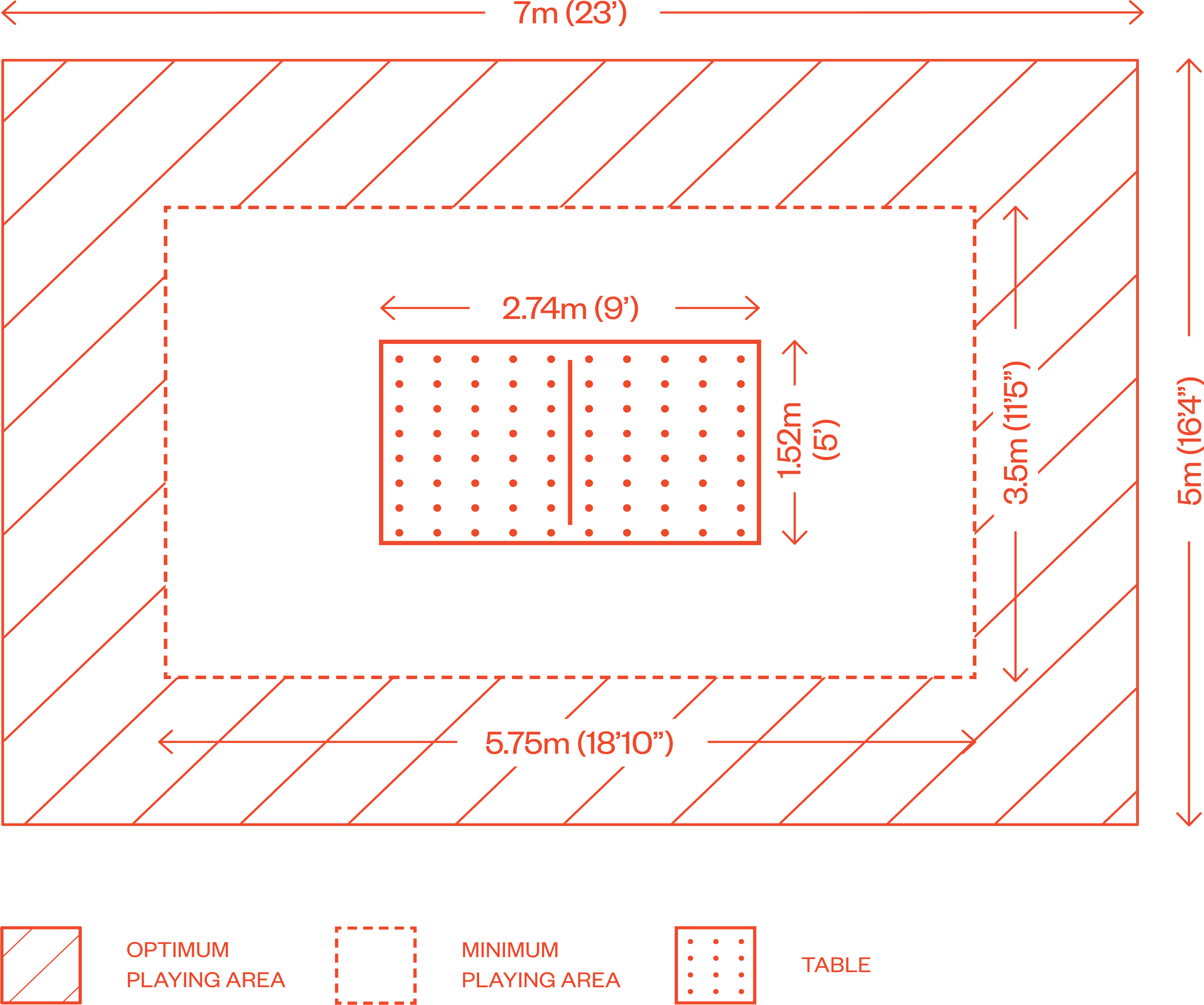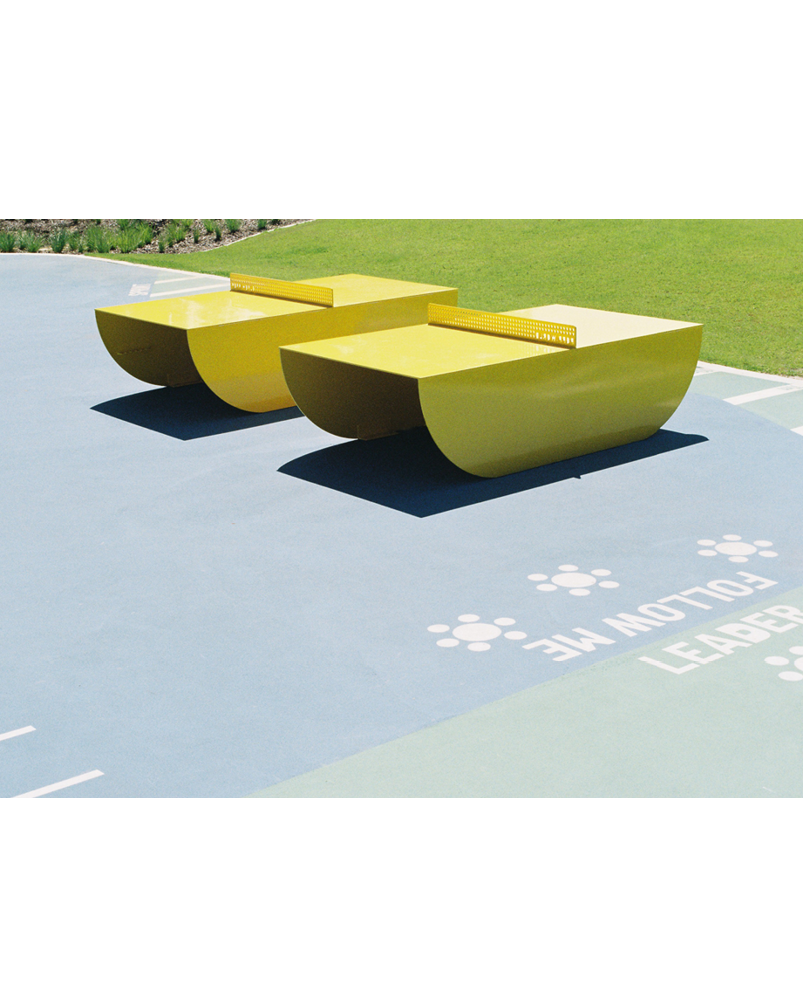Planning for a POPP Outdoor Table Tennis Table? Here's What To Consider...



Planning for an outdoor ping pong table should pose a few questions...So just how much space is required? What is the best surface for them to placed on? Can we use an existing space? Do we need to anchor them to the ground? The good thing is, these are great questions to be asking and they will ensure you choose a location that will allow for maximum playability and engagement. While each location is inherently different, there are some universal truths that apply to planning for a POPP table.
Here are our three pillars of ping pong planning...
1. Playing Surfaces
To start with - suitable playing surfaces can range from paving, concrete, asphalt, crushed granite, crushed limestone and pour-in-place (soft-fall) rubber with a formed substrate. The guidelines are that the surface be flat, level and hard-formed - which means this can include existing unused court spaces, courtyards, concourses or breakout areas.
We do also recommend that the table's securing footings be anchored directly into the ground. If necessary, sites can be prepared with a concrete slab or strip footings to allow the table to be anchored. This ensures longevity, security, and playability of your POPP table for generations to come.
To start with - suitable playing surfaces can range from paving, concrete, asphalt, crushed granite, crushed limestone and pour-in-place (soft-fall) rubber with a formed substrate. The guidelines are that the surface be flat, level and hard-formed - which means this can include existing unused court spaces, courtyards, concourses or breakout areas.
We do also recommend that the table's securing footings be anchored directly into the ground. If necessary, sites can be prepared with a concrete slab or strip footings to allow the table to be anchored. This ensures longevity, security, and playability of your POPP table for generations to come.
2. Playing Area
Take 5 big steps forward, then take 3 big steps to the side. Now imagine this space as a rectangle. This is the POPP minimum recommended playing area for a table (aka: 5.75 m x 3.5 m).
To get these dimensions, we have consulted with professional table tennis players and tried and tested a range of different playing area dimensions to find the balance between playability and a concise footprint. But we have to be honest with you, each 'court' can be different (shapes, dimensions and surfaces). There is no fixed size per se, so these recommendations are guidelines to show you what most of our customers work to.
So which playing area is right for our project?
It's really a case of horses for courses here, as each placement will invariably need to cater for different age groups, existing space limitations, the number of tables being placed etc.
If you’ve ever watched a game of table tennis being played at an Olympic level, you’ll know that competitors will regularly play from up to 2 meters away from the edge of the table. And while the everyday user at a park or school will often only require a third of this space – leaving enough room behind, and in front of your table, won’t limit gameplay as things start to get serious.
Take 5 big steps forward, then take 3 big steps to the side. Now imagine this space as a rectangle. This is the POPP minimum recommended playing area for a table (aka: 5.75 m x 3.5 m).
To get these dimensions, we have consulted with professional table tennis players and tried and tested a range of different playing area dimensions to find the balance between playability and a concise footprint. But we have to be honest with you, each 'court' can be different (shapes, dimensions and surfaces). There is no fixed size per se, so these recommendations are guidelines to show you what most of our customers work to.
So which playing area is right for our project?
It's really a case of horses for courses here, as each placement will invariably need to cater for different age groups, existing space limitations, the number of tables being placed etc.
If you’ve ever watched a game of table tennis being played at an Olympic level, you’ll know that competitors will regularly play from up to 2 meters away from the edge of the table. And while the everyday user at a park or school will often only require a third of this space – leaving enough room behind, and in front of your table, won’t limit gameplay as things start to get serious.
3. Surroundings
When deciding upon your final placement site, we encourage you to consider the benefits that other features around your site can impart upon a table's playability. With a bit of strategic planning - existing walls, buildings, trees and shrubs - can all be utilised as placemaking assets rather than obstacles.
3.1 Shade
While our ping pong tables are designed for year-round outdoor use, it's important to remember that our end users still need to be protected from harmful UV rays! Think about how nearby trees or buildings might be able to assist in providing full or partial shade during the hottest part of summer days.
3.2 Wind
Outdoor Ping Pong to Competitive Table Tennis is much like what Beach Volleyball is to Indoor Volleyball and it follows that whilst heavy weather conditions (gale force winds and storms) will obviously inhibit people’s ability to play - general wind will not hinder a casual game. However, positioning the tables where there are natural wind blocks - (buildings, large hedges or existing shade structures) - will help to minimise the impact of wind.
Point to note: Heavier outdoor ping pong balls can also be used, and also golf practice ‘wiffle balls’ (which allow wind to pass through the ball without causing deviations of its course), in consistently windy locations.
3.3 Soft Barriers
If there are pathways or other high traffic areas in the vicinity of your ping pong playing space, we would also recommend considering how other landscaping features could potentially act as a 'soft' barrier that will help restrict the loose balls from rolling too far from the action of a game. Small hedges or soft ground surfaces such as mulch or grass will do an excellent job at limiting the distance any runaway ball can travel, and in turn, will help to preserve game time that would otherwise be wasted chasing after them!
When deciding upon your final placement site, we encourage you to consider the benefits that other features around your site can impart upon a table's playability. With a bit of strategic planning - existing walls, buildings, trees and shrubs - can all be utilised as placemaking assets rather than obstacles.
3.1 Shade
While our ping pong tables are designed for year-round outdoor use, it's important to remember that our end users still need to be protected from harmful UV rays! Think about how nearby trees or buildings might be able to assist in providing full or partial shade during the hottest part of summer days.
3.2 Wind
Outdoor Ping Pong to Competitive Table Tennis is much like what Beach Volleyball is to Indoor Volleyball and it follows that whilst heavy weather conditions (gale force winds and storms) will obviously inhibit people’s ability to play - general wind will not hinder a casual game. However, positioning the tables where there are natural wind blocks - (buildings, large hedges or existing shade structures) - will help to minimise the impact of wind.
Point to note: Heavier outdoor ping pong balls can also be used, and also golf practice ‘wiffle balls’ (which allow wind to pass through the ball without causing deviations of its course), in consistently windy locations.
3.3 Soft Barriers
If there are pathways or other high traffic areas in the vicinity of your ping pong playing space, we would also recommend considering how other landscaping features could potentially act as a 'soft' barrier that will help restrict the loose balls from rolling too far from the action of a game. Small hedges or soft ground surfaces such as mulch or grass will do an excellent job at limiting the distance any runaway ball can travel, and in turn, will help to preserve game time that would otherwise be wasted chasing after them!
